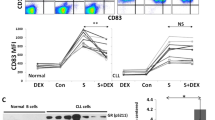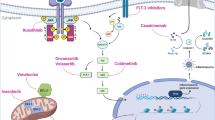Abstract
Glucocorticoid (GC) therapy occasionally relieves tumor-related fever and promotes tumor reduction in patients with chronic myelomonocytic leukemia (CMML). A mutation analysis of 24 patients with CMML revealed the relationship of GC effectiveness, defined as a monocyte reduction of > 50% within 3 days of methylprednisolone administration, with the MEFV single-nucleotide variant (SNV) and CBL mutation. Lipopolysaccharide-stimulated monocytes harboring MEFV E148Q produced greater amounts of IL-1β and TNF-α than did wild-type monocytes; this was effectively suppressed by GC. Primary CMML cells harboring the MEFV SNV and CBL mutation, and the myelomonocytic leukemia cell line GDM-1, harboring the CBL mutation, were both more significantly suppressed than non-mutated cells following GC treatment in the presence of GM-CSF. A loss-of-function CBL mutation prolonged STAT5 phosphorylation after GM-CSF stimulation, which was rapidly terminated in both patient samples and GDM-1 cells. In conclusion, GC therapy effectively treats CMML cells harboring the MEFV SNV and CBL mutation by reducing inflammatory cytokine production and terminating prolonged STAT5 phosphorylation in the GM-CSF signaling pathway.





Similar content being viewed by others
References
Vardiman JW, Thiele J, Arber DA, Brunning RD, Borowitz MJ, Porwit A, et al. The 2008 revision of the World Health Organization (WHO) classification of myeloid neoplasms and acute leukemia: rationale and important changes. Blood. 2009;114:937–51.
Parikh SA, Tefferi A. Chronic myelomonocytic leukemia: 2012 update on diagnosis, risk stratification, and management. Am J Hematol. 2012;87:610–9.
Itzykson R, Duchmann M, Lucas N, Solary E. CMML: clinical and molecular aspects. Int J Hematol. 2017;105:711–9.
Eissa H, Gooley TA, Sorror ML, Nguyen F, Scott BL, Doney K, et al. Allogeneic hematopoietic cell transplantation for chronic myelomonocytic leukemia: relapse-free survival is determined by karyotype and comorbidities. Biol Blood Marrow Transpl. 2011;17:908–15.
Wattel E, Guerci A, Hecquet B, Economopoulos T, Copplestone A, Mahe B, et al. A randomized trial of hydroxyurea versus VP16 in adult chronic myelomonocytic leukemia. Groupe Francais des Myelodysplasies and European CMML Group. Blood. 1996;88:2480–7.
Silverman LR. Randomized controlled trial of azacitidine in patients with the myelodysplastic syndrome: a study of the cancer and leukemia group B. J Clin Oncol. 2002;20:2429–40.
Aribi A, Borthakur G, Ravandi F, Shan J, Davisson J, Cortes J, et al. Activity of decitabine, a hypomethylating agent, in chronic myelomonocytic leukemia. Cancer. 2007;109:713–7.
Itzykson R, Kosmider O, Renneville A, Gelsi-Boyer V, Meggendorfer M, Morabito M, et al. Prognostic score including gene mutations in chronic myelomonocytic leukemia. J Clin Oncol. 2013;31:2428–36.
Patnaik MM, Lasho TL, Finke CM, Hanson CA, Hodnefield JM, Knudson RA, et al. Spliceosome mutations involving SRSF2, SF3B1, and U2AF35 in chronic myelomonocytic leukemia: prevalence, clinical correlates, and prognostic relevance. Am J Hematol. 2013;88:201–6.
Jankowska AM, Makishima H, Tiu RV, Szpurka H, Huang Y, Traina F, et al. Mutational spectrum analysis of chronic myelomonocytic leukemia includes genes associated with epigenetic regulation: UTX, EZH2, and DNMT3A. Blood. 2011;118:3932–41.
Bejar R, Lord A, Stevenson K, Bar-Natan M, Perez-Ladaga A, Zaneveld J, et al. TET2 mutations predict response to hypomethylating agents in myelodysplastic syndrome patients. Blood. 2014;124:2705–12.
Meldi K, Qin T, Buchi F, Droin N, Sotzen J, Micol JB, et al. Specific molecular signatures predict decitabine response in chronic myelomonocytic leukemia. J Clin Investig. 2015;125:1857–72.
Takimoto Y, Imanaka F. Chronic myelomonocytic leukemia with repeated respiratory failure associated with leukocytosis following splenic arterial embolization and splenectomy. Rinsho Ketsueki. 1996;37:1253–8.
Bourantas K, Tsiara S, Panteli A, Milionis C, Christou L. Pleural effusion in chronic myelomonocytic leukemia. Acta Haematol. 1998;99:34–7.
Jo T, Horio K, Migita K. Sweet’s syndrome in patients with MDS and MEFV mutations. N Engl J Med. 2015;372:686–8.
Celik S, Oktenli C, Kilicaslan E, Tangi F, Sayan O, Ozari HO, et al. Frequency of inherited variants in the MEFV gene in myelodysplastic syndrome and acute myeloid leukemia. Int J Hematol. 2012;95:285–90.
Padron E, Painter JS, Kunigal S, Mailloux AW, McGraw K, McDaniel JM, et al. GM-CSF-dependent pSTAT5 sensitivity is a feature with therapeutic potential in chronic myelomonocytic leukemia. Blood. 2013;121:5068–77.
Makishima H, Sugimoto Y, Szpurka H, Clemente MJ, Ng KP, Muramatsu H, et al. CBL mutation-related patterns of phosphorylation and sensitivity to tyrosine kinase inhibitors. Leukemia. 2012;26:1547–54.
Cancer Genome Atlas Research Network, Ley TJ, Miller C, Ding L, Raphael BJ, Mungall AJ, et al. Genomic and epigenomic landscapes of adult de novo acute myeloid leukemia. N Engl J Med. 2013;368:2059–74.
Kandoth C, McLellan MD, Vandin F, Ye K, Niu B, Lu C, et al. Mutational landscape and significance across 12 major cancer types. Nature. 2013;502:333–9.
Haferlach T, Nagata Y, Grossmann V, Okuno Y, Bacher U, Nagae G, et al. Landscape of genetic lesions in 944 patients with myelodysplastic syndromes. Leukemia. 2014;28:241–7.
Migita K, Nakamura T, Maeda Y, Miyashita T, Koga T, Tanaka M, et al. MEFV mutations in Japanese rheumatoid arthritis patients. Clin Exp Rheumatol. 2008;26:1091–4.
Migita K, Ida H, Moriuchi H, Agematsu K. Clinical relevance of MEFV gene mutations in Japanese patients with unexplained fever. J Rheumatol. 2012;39:875–7.
Selimoglu-Buet D, Wagner-Ballon O, Saada V, Bardet V, Itzykson R, Bencheikh L, et al. Characteristic repartition of monocyte subsets as a diagnostic signature of chronic myelomonocytic leukemia. Blood. 2015;125:3618–26.
Dayyani F. Mechanism of glucocorticoid-induced depletion of human CD14+CD16+ monocytes. J Leukoc Biol. 2003;74:33–9.
Goyama S, Schibler J, Gasilina A, Shrestha M, Lin S, Link KA, et al. UBASH3B/Sts-1-CBL axis regulates myeloid proliferation in human preleukemia induced by AML1-ETO. Leukemia. 2016;30:728–39.
Chae JJ, Aksentijevich I, Kastner DL. Advances in the understanding of familial Mediterranean fever and possibilities for targeted therapy. Br J Haematol. 2009;146:467–78.
Portincasa P, Scaccianoce G, Palasciano G. Familial mediterranean fever: a fascinating model of inherited autoinflammatory disorder. Eur J Clin Investig. 2013;43:1314–27.
Chae JJ, Cho YH, Lee GS, Cheng J, Liu PP, Feigenbaum L, et al. Gain-of-function Pyrin mutations induce NLRP3 protein-independent interleukin-1beta activation and severe autoinflammation in mice. Immunity. 2011;34:755–68.
Davtyan TK, Harutyunyan VA, Hakobyan GS, Avetisyan SA. Heightened endotoxin susceptibility of monocytes and neutrophils during familial Mediterranean fever. FEMS Immunol Med Microbiol. 2008;52:370–8.
Chae JJ, Komarow HD, Cheng J, Wood G, Raben N, Liu PP, et al. Targeted disruption of pyrin, the FMF protein, causes heightened sensitivity to endotoxin and a defect in macrophage apoptosis. Mol Cell. 2003;11:591–604.
Tsuchiya-Suzuki A, Yazaki M, Nakamura A, Yamazaki K, Agematsu K, Matsuda M, et al. Clinical and genetic features of familial Mediterranean fever in Japan. J Rheumatol. 2009;36:1671–6.
Migita K, Uehara R, Nakamura Y, Yasunami M, Tsuchiya-Suzuki A, Yazaki M, et al. Familial Mediterranean fever in Japan. Medicine (Baltimore). 2012;91:337–43.
Naimushin A, Lidar M, Ben Zvi I, Livneh A. The structural effect of the E148Q MEFV mutation on the pyrin protein: a study using a quantum chemistry model. Isr Med Assoc J. 2011;13:199–201.
Booth DR, Lachmann HJ, Gillmore JD, Booth SE, Hawkins PN. Prevalence and significance of the familial Mediterranean fever gene mutation encoding pyrin Q148. QJM. 2001;94:527–31.
Tone Y, Toma T, Toga A, Sakakibara Y, Wada T, Yabe M, et al. Enhanced exon 2 skipping caused by c.910G>A variant and alternative splicing of MEFV genes in two independent cases of familial Mediterranean fever. Mod Rheumatol. 2012;22:45–51.
Schmidt M, Lugering N, Lugering A, Pauels HG, Schulze-Osthoff K, Domschke W, et al. Role of the CD95/CD95 ligand system in glucocorticoid-induced monocyte apoptosis. J Immunol. 2001;166:1344–51.
Schmidt M, Pauels HG, Lugering N, Lugering A, Domschke W, Kucharzik T. Glucocorticoids induce apoptosis in human monocytes: potential role of IL-1 beta. J Immunol. 1999;163:3484–90.
Fingerle-Rowson G, Angstwurm M, Andreesen R, Ziegler-Heitbrock HW. Selective depletion of CD14+CD16+ monocytes by glucocorticoid therapy. Clin Exp Immunol. 1998;112:501–6.
Manukyan G, Aminov R, Hakobyan G, Davtyan T. Accelerated apoptosis of neutrophils in familial Mediterranean fever. Front Immunol. 2015;6:239.
Lukens JR, Barr MJ, Chaplin DD, Chi H, Kanneganti TD. Inflammasome-derived IL-1beta regulates the production of GM-CSF by CD4(+) T cells and gammadelta T cells. J Immunol. 2012;188:3107–15.
Fujikura K. Global epidemiology of Familial Mediterranean fever mutations using population exome sequences. Mol Genet Genom Med. 2015;3:272–82.
Sanada M, Suzuki T, Shih LY, Otsu M, Kato M, Yamazaki S, et al. Gain-of-function of mutated C-CBL tumour suppressor in myeloid neoplasms. Nature. 2009;460:904–8.
Schmidt MH, Dikic I. The Cbl interactome and its functions. Nat Rev Mol Cell Biol. 2005;6:907–18.
Ogawa S, Shih LY, Suzuki T, Otsu M, Nakauchi H, Koeffler HP, et al. Deregulated intracellular signaling by mutated c-CBL in myeloid neoplasms. Clin Cancer Res. 2010;16:3825–31.
Acknowledgements
This work was partially supported by a research grant from Merck, Sharp, and Dohme (MSD).
Author information
Authors and Affiliations
Contributions
JW and FK designed this study. JW performed all experiments and wrote the paper. YO provided support for the sequencing analysis and ELISA. JW performed statistical analyses. FK, SK, and KS commented on the draft. JW, TH, SK, RH-S. TM, TY, and AK collected data. All authors reviewed the final version of the manuscript.
Corresponding author
Ethics declarations
Conflict of interest
FK has received a research grant from Merck, Sharp, and Dohme (MSD) for this study. The remaining authors declare no competing financial interests.
Electronic supplementary material
Below is the link to the electronic supplementary material.
About this article
Cite this article
Watanabe, J., Sato, K., Osawa, Y. et al. CBL mutation and MEFV single-nucleotide variant are important genetic predictors of tumor reduction in glucocorticoid-treated patients with chronic myelomonocytic leukemia. Int J Hematol 108, 47–57 (2018). https://doi.org/10.1007/s12185-018-2436-0
Received:
Revised:
Accepted:
Published:
Issue Date:
DOI: https://doi.org/10.1007/s12185-018-2436-0




